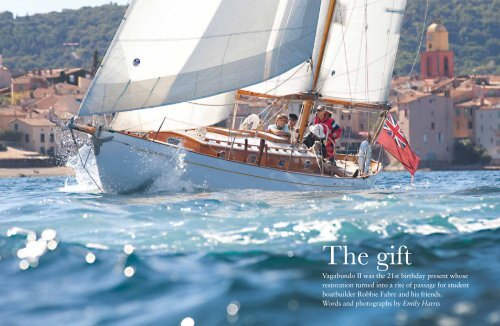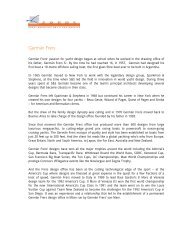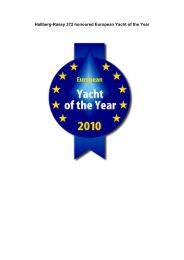Vagabundo II was the 21st birthday present whose ... - German Frers
Vagabundo II was the 21st birthday present whose ... - German Frers
Vagabundo II was the 21st birthday present whose ... - German Frers
Create successful ePaper yourself
Turn your PDF publications into a flip-book with our unique Google optimized e-Paper software.
The gift<br />
<strong>Vagabundo</strong> <strong>II</strong> <strong>was</strong> <strong>the</strong> <strong>21st</strong> <strong>birthday</strong> <strong>present</strong> <strong>whose</strong><br />
restoration turned into a rite of passage for student<br />
boatbuilder Robbie Fabre and his friends.<br />
Words and photographs by Emily Harris
VAGABUNDO <strong>II</strong><br />
Above: Owner,<br />
restorer and now<br />
skipper: Robbie<br />
Fabre at <strong>the</strong> helm<br />
The water <strong>was</strong> getting darker and more<br />
mottled by <strong>the</strong> second, as <strong>the</strong> wind,<br />
blowing from <strong>the</strong> north, descended over<br />
<strong>the</strong> Gulf of Saint-Tropez at a rate of<br />
knots. Yacht <strong>Vagabundo</strong> <strong>II</strong>, <strong>the</strong> 42ft<br />
(12.8m) <strong>German</strong> <strong>Frers</strong> ketch built in<br />
1945, <strong>was</strong> heeling over but not hard pressed. I’d been up<br />
<strong>the</strong> mast for 20 minutes waiting for more wind to ensure<br />
a good shot of pressure in her sails. It <strong>was</strong> uncomfortable<br />
– and <strong>the</strong>n it all got a bit too much. My leg <strong>was</strong> pinched<br />
between a shroud and <strong>the</strong> spreader in order to make my<br />
two hands available for my camera; I’d got <strong>the</strong> shot but<br />
<strong>the</strong> mainsail had been eased in order to depower her,<br />
which <strong>was</strong>n’t great for me. The wind <strong>was</strong> getting up –<br />
my ‘exit strategy’ needed to be put into action.<br />
Robbie Fabre, <strong>the</strong> 23-year-old skipper and new owner,<br />
delegated <strong>the</strong> job of easing <strong>the</strong> halyard in order to get me<br />
down, to his end-of-season crew, younger bro<strong>the</strong>r Henry<br />
and Tano Noblia (his regular crew having gone back to<br />
<strong>the</strong>ir universities in <strong>the</strong> UK after Les Voiles de Saint-<br />
Tropez), and I <strong>was</strong> on deck in a flash.<br />
We were in company of <strong>the</strong> mistral – <strong>the</strong> dry, strong<br />
wind that blows offshore in <strong>the</strong> south of France. Robbie<br />
and crew all went from aviator sunglasses cool to getting<br />
soaked on <strong>the</strong> foredeck, knocked by every wave but not<br />
blinking an eye. This <strong>was</strong> a small fraction of what this<br />
yacht may have experienced in her early life off Argentina<br />
during <strong>the</strong> war, when her home waters were not littered<br />
by mines, like Britain’s, but clean, in <strong>the</strong> South Atlantic.<br />
Her history is quite unusual for a Saint-Tropez classic.<br />
It is rich in racing, in particular <strong>the</strong> unofficial 1940s races<br />
that helped develop <strong>the</strong> endurance-based 1,200-mile, first<br />
Buenos Aires-Rio de Janeiro race in 1947, in which she<br />
came second overall. From <strong>the</strong>se races her lines were<br />
chosen for <strong>the</strong> <strong>Frers</strong>-designed Boreal class.<br />
Robbie and his crew were working hard toge<strong>the</strong>r to<br />
get <strong>the</strong> foresail down and at least secured by a sail tie as<br />
<strong>the</strong> wind <strong>was</strong> becoming overwhelming. Meanwhile his<br />
mo<strong>the</strong>r Caroline <strong>was</strong> left in command of <strong>Vagabundo</strong>,<br />
also getting soaked but stoically helming us homeward.<br />
Family oF shipowners<br />
The Fabre family, which has a history of shipping and<br />
ship-owning that dates back to <strong>the</strong> 15th century, lives in<br />
Bristol and has a house in Port Grimaud, near Saint-<br />
Tropez, where I had arrived <strong>the</strong> day before to meet <strong>the</strong>m.<br />
Inside, Philippe Fabre sat in his round lower-level<br />
drawing room with a coffee in one hand and <strong>the</strong> o<strong>the</strong>r<br />
casually referencing <strong>the</strong> 20- or 30-something books,<br />
magazines, and naval drawings that were strewn over <strong>the</strong><br />
coffee table in front of him. The family’s vivid Fabre<br />
Shipping colonial-era posters, <strong>the</strong>ir bows floating proud,<br />
Above and previous<br />
10 CLASSIC BOAT FEBRUARY 2012 CLASSIC BOAT FEBRUARY 2012 11<br />
spread: The<br />
newly-restored<br />
<strong>Vagabundo</strong> <strong>II</strong> off<br />
Saint-Tropez<br />
Right: White paint<br />
and varnished<br />
woodwork give a<br />
clean, light look<br />
below
VAGABUNDO <strong>II</strong><br />
Above:<br />
<strong>Vagabundo</strong>’s<br />
lines were<br />
adopted for <strong>the</strong><br />
Boreal class<br />
VAGABUNDO <strong>II</strong><br />
designed<br />
<strong>German</strong> <strong>Frers</strong>, 1945<br />
Built<br />
Domingo Catani,<br />
San Isidro, Argentina<br />
length Overall<br />
42ft 4in (12.9m)<br />
length waterline<br />
31ft 2in (9.5m)<br />
Beam<br />
10ft 6in (3.2m)<br />
draught plate up<br />
5ft 7in (1.7m)<br />
draught plate dOwn<br />
8ft (2.5m)<br />
were displayed on every wall. Philippe’s two sons had<br />
come in with warps coiled up in <strong>the</strong>ir hands. It had taken<br />
me an hour to work out that <strong>Vagabundo</strong> <strong>II</strong> <strong>was</strong> right<br />
outside – in <strong>the</strong>ir ‘backyard’, through <strong>the</strong> blinds, in <strong>the</strong><br />
water! She lay near Philippe’s o<strong>the</strong>r yacht Freya, a 47ft<br />
(14.3m) Bill Dixon sloop.<br />
Considering Philippe has a collection of yachts, I<br />
wondered why <strong>the</strong> Fabres had acquired <strong>Vagabundo</strong> <strong>II</strong>.<br />
As we went to a café in his son Robbie’s Boston Whaler,<br />
Philippe insisted that buying <strong>Vagabundo</strong> had been a<br />
mistake – he’d thought she <strong>was</strong> his fa<strong>the</strong>r’s friend’s yacht<br />
Escorpion. He had come across <strong>the</strong> boat via telephone<br />
and email, through a friend who had found her in Port<br />
Cogolin, Saint-Tropez. This friend described her as being<br />
“<strong>the</strong> perfect boat for Robbie”, and Philippe instinctively<br />
acquired her on <strong>the</strong> basis of seeing some photographs on<br />
his iPad computer.<br />
BeneFicial mistake<br />
Philippe had been looking for a boat for his son Robbie’s<br />
<strong>21st</strong> <strong>birthday</strong> in 2010. His gift of a yacht <strong>was</strong> to develop<br />
Robbie’s marine career, for him to experience <strong>the</strong><br />
responsibility of owning and skippering a racing yacht as<br />
an extension of his future professional career in <strong>the</strong><br />
design and build of sailing vessels. Robbie is currently<br />
enrolled at <strong>the</strong> International Boatbuilding Training<br />
College, Lowestoft, after gaining qualifications in<br />
Marine Technology at Plymouth and Boat Design and<br />
Production at Falmouth. Although <strong>Vagabundo</strong> <strong>was</strong>n’t<br />
Philippe’s friend’s yacht, <strong>the</strong> family discovered her history<br />
and realised what a beneficial mistake she had been!<br />
In <strong>the</strong> café Robbie reeled off particular jobs he<br />
undertook during <strong>the</strong> restoration. I had originally met<br />
Philippe and Robbie on one of <strong>the</strong> last few days of Les<br />
Voiles de Saint-Tropez, on <strong>the</strong> foredeck of <strong>Vagabundo</strong>,<br />
surrounded by his fellow marine graduates, and I’d<br />
experienced <strong>the</strong> heady sense of young team energy.<br />
Robbie’s infectious enthusiasm made him seem as if he<br />
might just untie <strong>the</strong> lines without us noticing and nip out<br />
for a match race or a sail in <strong>the</strong> dark! Far from <strong>the</strong> Irish<br />
Bar antics that <strong>the</strong> o<strong>the</strong>r young crews preferred, he <strong>was</strong><br />
telling yarns as if he’d been at sea for years.<br />
The energy <strong>was</strong> still <strong>present</strong> as he described to me <strong>the</strong><br />
work he carried out on <strong>Vagabundo</strong> once he’d<br />
transported her from Port Cogolin, near Saint-Tropez, to<br />
Southampton in December 2010, minus her rigging, but<br />
o<strong>the</strong>rwise a seemingly perfect boat in need of a minor<br />
facelift and a few personal alterations to suit her new<br />
owner. She had been lying hidden and covered up in Port<br />
Cogolin for two years before <strong>the</strong> Fabres bought her. “On<br />
<strong>the</strong> surface, cosmetically she <strong>was</strong> just immaculate – she<br />
blossomed in our eyes, [but] on closer inspection <strong>the</strong><br />
sparkling interior hid <strong>the</strong> rot around <strong>the</strong> engine... After<br />
using every bluff in <strong>the</strong> book <strong>the</strong>re <strong>was</strong> nothing to stop<br />
my friend (<strong>the</strong> determined surveyor) from bludgeoning<br />
his way through what <strong>was</strong> in my mind <strong>the</strong> perfect<br />
interior, with a power tool and no plot,” said Robbie.<br />
previous reBuild<br />
From <strong>the</strong>n on Robbie knew that <strong>Vagabundo</strong>’s ceilings<br />
(<strong>the</strong> hull linings) would have to come out. Luckily <strong>the</strong><br />
planking and frames had not proved to be in a similar<br />
state of decay. Her previous owners Miguel and Sonia<br />
Carril, who acquired her from <strong>the</strong>ir fa<strong>the</strong>r Justo del<br />
Carril in 1976, rebuilt her as new in 2003 under <strong>the</strong><br />
watchful eye of designer <strong>German</strong> <strong>Frers</strong> himself.<br />
On completion <strong>the</strong>y <strong>the</strong>n took her cruising <strong>the</strong> Brazilian<br />
shore, reaching Rio and Bahia, and crossed <strong>the</strong> Atlantic to<br />
Argentario, Italy. They competed in <strong>the</strong> Panerai Argentario<br />
Sailing Week 2007 with <strong>Frers</strong> at <strong>the</strong> helm and came first<br />
overall in <strong>the</strong> 15m LOA classic division.<br />
But though in terms of sea miles she <strong>was</strong> being<br />
successfully cruised and used, this period took its toll on<br />
<strong>Vagabundo</strong>’s structural condition, exacerbated by <strong>the</strong><br />
lack of ventilation when she <strong>was</strong> laid up in Port Cogolin.<br />
In addition, <strong>the</strong> angle at which <strong>the</strong> steering pulleys had<br />
been placed had caused movement in <strong>the</strong> cockpit sides<br />
and to <strong>the</strong> hull. Robbie fitted a stainless-steel structure to<br />
Above: The<br />
predominantly<br />
white interior<br />
follows tradition;<br />
<strong>the</strong> boat is fitted<br />
out for comfortable<br />
cruising as well as<br />
racing<br />
12 CLASSIC BOAT FEBRUARY 2012 CLASSIC BOAT FEBRUARY 2012 13
VAGABUNDO <strong>II</strong><br />
Above: Deck crew:<br />
left and far right,<br />
friend Tano<br />
Noblia; centre<br />
(blond hair),<br />
Henry, Robbie’s<br />
younger bro<strong>the</strong>r<br />
“Boatbuilding paralysis had set in. It <strong>was</strong> a pinnacle moment.<br />
We wanted to carry on but had run out of energy.”<br />
stiffen that area and improve access to <strong>the</strong> cockpit sole<br />
and steering system. The Mediterranean’s stern-to<br />
mooring habit meant that movement had also occurred<br />
in <strong>the</strong> taffrail and had cracked <strong>the</strong> floor <strong>the</strong>re. Stainlesssteel<br />
bolts were inserted to <strong>the</strong> forward face of <strong>the</strong><br />
taffrail and through <strong>the</strong> 75mm-deep quarter knees.<br />
Fairing to <strong>the</strong> capping rail and counter <strong>was</strong> started, and<br />
a cracked floor discovered and replaced.<br />
Robbie had soon realised that if he <strong>was</strong> to correct <strong>the</strong><br />
problems highhlighted by <strong>the</strong> survey (many of <strong>the</strong>m<br />
unexpected) and have <strong>Vagabundo</strong> ready to sail to <strong>the</strong><br />
Med in June, he needed some help. The answer <strong>was</strong> to<br />
recruit fellow students from <strong>the</strong> IBTC at Lowestoft. They<br />
would commute to Southampton for long weekends (and<br />
sometimes longer), sleeping on board to make <strong>the</strong> most<br />
of <strong>the</strong>ir time and save money. Unfortunately <strong>the</strong><br />
portholes had been removed at an early stage and sent<br />
away to be stripped, re-chromed and resealed. “Even our<br />
drinks would freeze overnight,” says Robbie.<br />
The extremes of wea<strong>the</strong>r also affected <strong>Vagabundo</strong>’s<br />
teak deck, which moved, meaning about half <strong>the</strong> seams<br />
needed raking out and resealing. It had also split in<br />
certain places and had to be routed and splined.<br />
Ano<strong>the</strong>r major job involved <strong>the</strong> 74hp Yanmar engine.<br />
Its waterlock and filter had to be made more accessible,<br />
but also <strong>the</strong> engine mounts needed investigating as <strong>the</strong>y<br />
set up an annoying knocking at certain RPMs. During<br />
that process, <strong>the</strong> engine <strong>was</strong> moved to <strong>the</strong> saloon, where<br />
it became <strong>the</strong> boys’ bedside table.<br />
The grey-water system <strong>was</strong> removed to gain access to<br />
keel bolts and limber holes. The refrigeration system <strong>was</strong><br />
reorganised to run off domestic batteries, helped by a<br />
keel cooling system – so easing off strain on <strong>the</strong> engine<br />
when cruising, especially in <strong>the</strong> Med. The anchor locker<br />
<strong>was</strong> remodelled to a third of its size, and made to drain<br />
away to <strong>the</strong> grey-water system.<br />
‘dinosaur’ centreBoard<br />
Progress on fixing <strong>the</strong> drop-down centreboard (which<br />
adds 75cm to <strong>the</strong> draught), however, <strong>was</strong> “nothing short<br />
of glacial”, according to Robbie. The operating motor<br />
<strong>was</strong> taken out to be reconditioned, but condemned as<br />
too far gone. After spending some time deliberating over<br />
a manual system, and deciding it would intrude to much<br />
into <strong>the</strong> accommodation, <strong>the</strong>y decided to fit a new motor<br />
to <strong>the</strong> ‘dinosaur’ mechanism and revisit <strong>the</strong> job this winter.<br />
Making <strong>the</strong> new sails meant an unscheduled drive to<br />
Port Grimaud to pick up <strong>the</strong> old ones and get<br />
measurements. Blocks were made to match and Harken<br />
tracks were replaced with more traditional, and longer,<br />
ones by Dryade. In March, <strong>the</strong> job of sanding back <strong>the</strong><br />
varnish began: 16-hour shifts day after day by <strong>the</strong> IBTC<br />
crew, and even after a good vacuuming <strong>the</strong>ir sleeping<br />
bags, as Robbie put it, “looked as if <strong>the</strong>y had spent <strong>the</strong><br />
night in <strong>the</strong> Atacama Desert.”<br />
By now, burn-out at <strong>the</strong> end of a long weekend <strong>was</strong><br />
<strong>the</strong> norm as Robbie and his friends, fuelled by a diet of<br />
Haribos and Red Bull, drove <strong>the</strong>mselves on, until one<br />
weekend, as Robbie puts it, after arriving back at<br />
Lowestoft, “We were mere embers on <strong>the</strong> living-room<br />
floor. Boatbuilding paralysis had set in. It <strong>was</strong> a<br />
pinnacle moment. We wanted to carry on but had run<br />
out of energy.”<br />
But it <strong>was</strong> also <strong>the</strong> turning of <strong>the</strong> tide. The portholes<br />
were ready for collection, new parts were ready to fit.<br />
Soon <strong>the</strong> boat <strong>was</strong> tidy and painting could begin. With a<br />
Royal Wedding and ano<strong>the</strong>r Bank Holiday to provide<br />
more time, <strong>the</strong> day <strong>the</strong> shed <strong>was</strong> dismantled approached<br />
rapidly. The brief sea trials in Southampton revealed a<br />
healthy wooden-boat-problem list for <strong>the</strong> south of<br />
France where <strong>Vagabundo</strong> <strong>II</strong> would arrive in late June.<br />
Robbie, who is so fired up by this project, seems to<br />
have no problem finding crew. During “<strong>the</strong> Voiles,” as he<br />
calls it, “we had sailors from several UK colleges and<br />
universities. They were close friends or at least, if <strong>the</strong>y<br />
weren’t <strong>the</strong>y were girlfriends of boatbuilders!” He<br />
eagerly reels off his entourage: “Well <strong>the</strong>re’s Sam<br />
Masterman – my right-hand man – super reliable from<br />
Above: View from<br />
<strong>the</strong> mast-top<br />
Left: Crew on<br />
board<br />
Below left: A tidy<br />
transom<br />
14 CLASSIC BOAT FEBRUARY 2012 CLASSIC BOAT FEBRUARY 2012 15
VAGABUNDO <strong>II</strong><br />
Above, clockwise<br />
from top left: The<br />
signature curved<br />
companionway;<br />
Caroline Fabre,<br />
Robbie’s mum, on<br />
<strong>the</strong> helm; under<br />
restoration in <strong>the</strong><br />
tent at<br />
Southampton;<br />
restoration team<br />
slept aboard<br />
16 CLASSIC BOAT FEBRUARY 2012<br />
Jersey, loves a bit of wea<strong>the</strong>r, he’s my bosun. Atlantic Al,<br />
our trimmer, a graduate from Falmouth University who’s<br />
started a sail loft in Fowey, Sail Shape Ltd. Then <strong>the</strong>re’s<br />
Fork Lift Al (named for his super strength) who is our<br />
Italian mastman studying at Lowestoft; William Holt,<br />
our resident dinghy sailor from Plymouth University;<br />
Peter Trevis who cycles from St Rafael – he had no<br />
money this year after having such a good time at<br />
Plymouth University on <strong>the</strong> Marine Tech course. Plus his<br />
girlfriend Rachel, <strong>the</strong> boat’s resident mum.”<br />
The launch party in Port Grimaud, with family, friends<br />
and fireworks, <strong>was</strong> a celebration of Robbie’s new<br />
ownership of this gleaming restored yacht, <strong>Vagabundo</strong> <strong>II</strong>.<br />
signature Feature<br />
The most unique feature on board <strong>Vagabundo</strong> is her<br />
companionway, placed on <strong>the</strong> starboard side amidships.<br />
It’s not a contrived recent feature though; it is <strong>the</strong><br />
<strong>German</strong> <strong>Frers</strong> design signature. <strong>Vagabundo</strong> <strong>II</strong> <strong>was</strong> born<br />
out of a bout of depression <strong>Frers</strong> experienced after<br />
designing his second yacht for himself, Fjord <strong>II</strong>, which he<br />
reluctantly sold in 1943. He consequently shut himself<br />
away to draw <strong>Vagabundo</strong> <strong>II</strong>.<br />
Down below, <strong>the</strong>re are six berths which are<br />
complemented by good standing headroom and a<br />
practical galley which lies opposite <strong>the</strong> companionway<br />
and contains vertical and quite industrial looking fridges<br />
with stainless-steel lids. These lids double up as clean<br />
worktops and emphasise that while <strong>the</strong> varnishing gives<br />
you a warm feeling about <strong>the</strong> boat, <strong>the</strong>re is also a slightly<br />
utilitarian or at least, super practical feel to <strong>the</strong> décor.<br />
Robbie supposes he needs eight crew onboard ideally.<br />
He talked about <strong>the</strong> things he wants to improve. The<br />
winches – he’d like to minimise <strong>the</strong>m at some stage.<br />
There’s a new switchboard, but <strong>the</strong> electric system itself<br />
is useless and he will be rewiring <strong>the</strong> boat in time. He<br />
also mentioned that <strong>the</strong> long wooden-boat-list <strong>was</strong>n’t<br />
completely fixed. His autopilot might need a tweak, it<br />
seems; sailing singlehanded through anchored Wally<br />
yachts in a mistral <strong>was</strong> not ideal. The centreboard motor<br />
is still jammed and seized in <strong>the</strong> down position. This <strong>was</strong><br />
Robbie’s excuse for not winning Les Voiles de Saint-<br />
Tropez – not being able to get <strong>the</strong> keel up when running<br />
<strong>was</strong> a disadvantage.<br />
The crew’s performance as an under-25-year-old crew,<br />
in what is quite a mature scene, has not just been fun, it<br />
seems to have put <strong>the</strong>ir training and <strong>the</strong>ir understanding<br />
of yacht construction, design and building into context.<br />
Awards like second prize in <strong>the</strong> Epoque Marconi<br />
Division of Les Voiles de Saint-Tropez can only spur on<br />
Robbie Fabre’s hunger to bring his young crew back<br />
toge<strong>the</strong>r for more racing (and more fixing?) next year.





